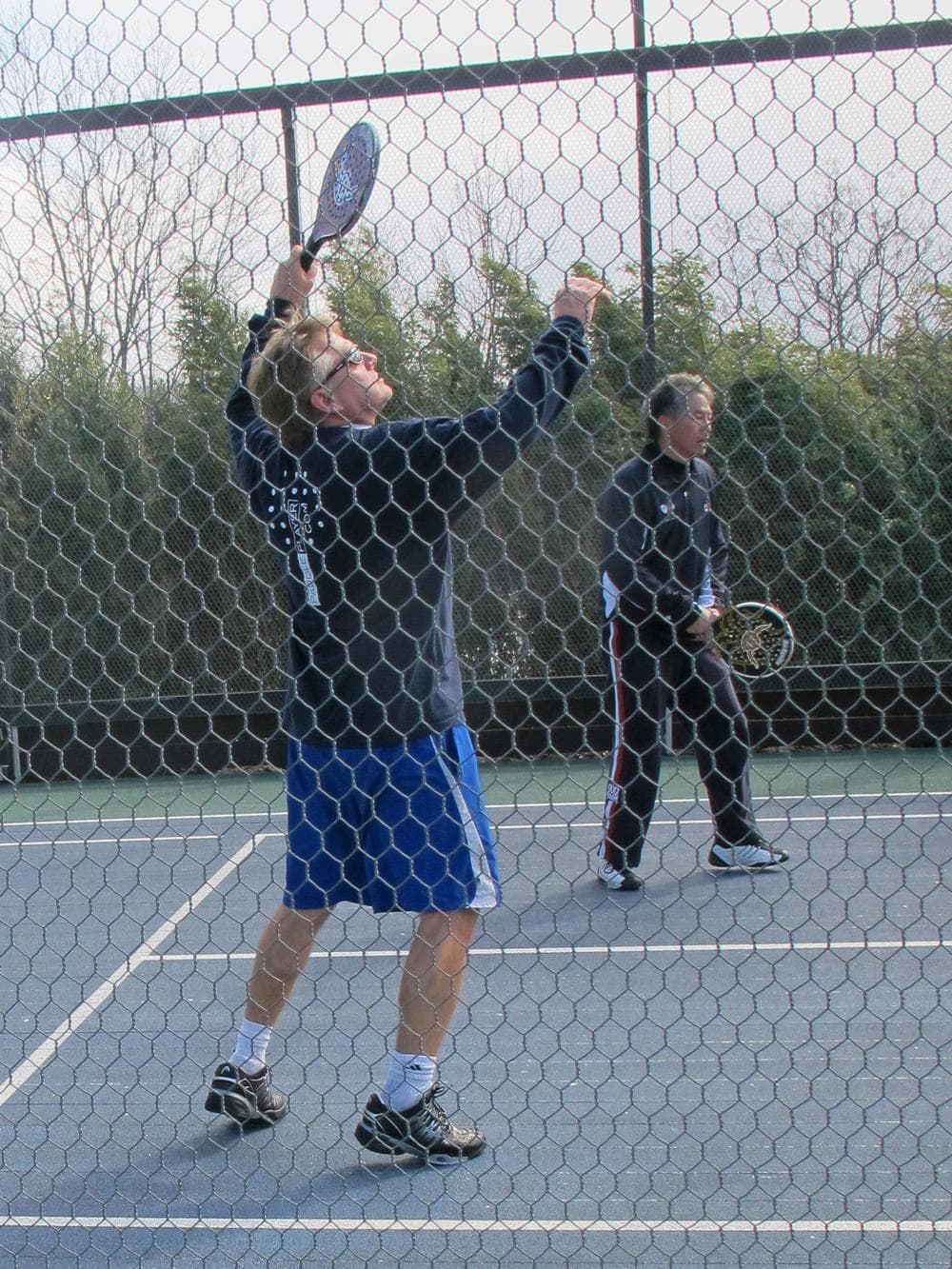Advertisement
Platform Tennis: Elevated, Outside, Caged In
ResumePlatform tennis features intense competition in a small area surrounded by chicken wire. You might call it tennis’s version of a steel cage match … if the players weren’t so darn friendly.
“So imagine a tennis court, but it’s only 20 feet wide by 40 feet long. Has a net in the middle, it looks just like a tennis court, service boxes, alleys,” American Platform Tennis Association President Tim McAvoy explained. “But, outside of the court, right next to court, is chicken wire, tight wire that surrounds the court.”
Those chicken-wire cages extend 12 feet in the air and give the game of platform tennis a sound all its own. When a ball hits the cage, the wires let out a vibrating metallic shimmer.
“You play the sport [by] the same [rules] as tennis. You have to hit [the ball] over the net. It has to land in the court, but if you hit it hard enough, it goes over the net lands in the court it can hit the wire, or 'the cage,'” said McAvoy, who lives in Phoenixville, Pennsylvania and has been playing platform tennis for nearly 30 years. “It hits the wires and you can play it off the wires before it bounces a second time on your side. So, that’s what takes away just the raw, brute power and makes it much more of a kind of a chess match.”
This weekend on Long Island, New York more than 400 men and women are playing in the American Platform Tennis Association’s national championships. On February 24-25, Centercourt Athletic Club in Chatham, New Jersey was one of five local clubs hosting championships for men and women in age groups ranging from over 40 to over 65.
That Saturday, the skies were clear, but it was chilly and the wind was whipping through the courts. McAvoy says platform tennis players don’t think about the weather.

“There are heaters underneath because if it’s snowing or there’s ice, you play. The heaters melt the snow or the ice,” McAvoy said. “The surface of the court, the aluminum surface, has rough grit on it, almost like sand that’s been painted into it. So the balls don’t skid when it’s wet.”
Platform tennis was invented by two men in Scarsdale, New York in the 1920s, according to APTA Executive Director Ann Sheedy.
“They were tennis players and they wanted to get out of the house in the winter. And so they created a wooden platform and they got tired of chasing the ball in the snow, so that’s how they came up with the idea of putting the screens around the court,” Sheedy said, while sitting inside the Centercourt clubhouse. “One time somebody played the ball off the screen and they thought that was a great addition to the sport.”
The balls are neon green like a regular tennis ball, but have a solid foam rubber core. The racquets look like oversized ping pong paddles with holes drilled through them.
One quick point of clarification: many platform tennis players call their game “paddle tennis.” However, there is a separate racquet sport officially known as “paddle tennis” [But that’s a story for another edition of Only A Game.]
John Milbank is a tennis pro at a country club in Morristown, New Jersey. He first heard about platform while working at another local club.
“For six years, I refused to even go up and look at it, it looked so silly,” Milbank said.
But 20 years ago, he gave it a shot and got hooked. Platform is a doubles game and Milbank and his partner, Mike Atkinson of Sparta, went on to win last month’s men’s 45-and-older title.
Milbank says it’s a humbling sport for regular tennis players who are used to admiring their own aces and winners.
“The points are so long and if you’re kind of stuck on yourself, it’s easy to kind of get frustrated when guys are getting balls back. You might be dominating the point and lose it anyway,” Milbank said. “And it might be a super-long point, but the teams that hustle and have a will rather than get caught up in their own skill, they tend to play better.”
Some of the worst-behaved tennis players actually end up being nice on the paddle court. It’s still competitive, but there's something about our group that just won’t allow that kind of bad behavior.
Cindy Prendergast, three-time APTA women's national champion
Platform players call their opponents’ shots in or out. Line judges are only used at championship finals. Wilmington, Delaware resident Cindy Prendergast, who has won multiple women’s and mixed national championships, says sportsmanship is part of the culture.
“Some of the worst-behaved tennis players actually end up being nice on the paddle court. It’s still competitive, but there's something about our group that just won’t allow that kind of bad behavior,” Prendergast said. “So we all just really try hard and we compete hard, but at the end of the day we have a beer with each other and get ready for the next tournament.”
Platform’s traditional hub is in the Tri-State area of New York, New Jersey, and Connecticut. But the APTA reports that Chicago has the fastest growing U.S. platform community. There’s also been some growth in Atlanta and parts of Florida and Arizona.
Platform hit its peak in the 1970s when there were sponsors and cash prizes for major tournaments. A court with a heater can cost as much $70,000 – one reason it’s primarily a country club sport.
[sidebar title="The 'Other' Tennis" width="200" align="right"] Platform tennis players take pride in the sportsmanship and camaraderie of their game. In May 2011, Bill Littlefield spoke with Stephen Tignor about his book, High Strung: Bjorn Borg, John McEnroe, and the Untold Story of Tennis's Fiercest Rivalry[/sidebar]For February’s championship events, only a handful of spectators turned out, but the sport has fans in the world of elite tennis. Todd Martin was once ranked 4th in the world, played on the 1995 U.S. Davis Cup championship team, and reached the finals in the Australian and U.S opens.
“I grew up in the Midwest, in very cold climates. So my dad and I used to, when it was cold out and when it was snowing, we’d go down to the platform tennis court and play that,” Martin said, after participating in panel discussion at the MIT Sloan Sports Analytics Conference in Boston in early March. “It was a lot of fun for me because I got to play with adults and play doubles.”
After a long time away from platform, Martin picked up a racquet a few years ago.
“The game is really interesting and you gotta be careful about how hard you hit the ball and it’s dangerous because you’re playing with a heavy ball and oftentimes the best solution is to try to hit the guy on the other side of the court,” said the former U.S. Olympian. “It’s a game that I know lots of the guys that I played junior tennis with play awfully well now.”
Former APTA President Mark Fischl summed up the allure of a small, outdoor tennis court inside a chicken-wire fence.
“Most winters, unlike this one, it'll be 10 degrees out, the wind will be howling, there'll be weather warnings: ‘Stay inside, bundle up, if you go out, go out for short periods.’ And I'll be going out to play and we'll play an hour and a half, two hours,” Fischl said during a break in the action at the Short Hills Club last month. “We'll have a beer afterwards, and I'll drive home and I'll have icicles on the tip of my hair. But I just spent two hours with my buddies outside, got some great exercise and had a blast. How could you not be addicted?”
The American Platform Tennis Association’s national championships continue Saturday in New York with the men’s and women’s finals scheduled for Sunday, March 18.
This segment aired on March 17, 2012.
